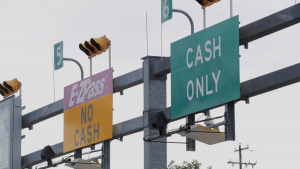
The Pennsylvania Turnpike will transition to cashless tolling before the end of 2021.
The transition has been in the making for years as the 552-mile Turnpike has been adding more and more electronic tolling stations. The locations have been part of a pilot program for cashless tolling.
“Cashless tolling has been adopted by dozens of agencies across the United States because of the improved safety and mobility it provides,” said Turnpike CEO Mark Compton. “Everybody pays electronically, so there’s no need to stop; everyone benefits from the convenience of uninterrupted travel. Plus, cash and E-ZPass customers no longer need to dart across tollbooth traffic to reach their lanes.”
In 2016, cashless tolling made its debut on the Turnpike in Lower Bucks County.
The new statewide cashless toll system will employ a toll by license plate system. Drivers who don’t have E-ZPass will receive a bill by mail and nothing will change for E-ZPass customers.
The Turnpike said in a statement that they have committed to no layoffs before January 1, 2022. Before that date and after cashless tolling begins, staff will man toll plazas to offer assistance to customers.
“As we move towards all-electronic tolling, we will continue to do all we can to help transition impacted employees — whether that means moving to another position here at the Pennsylvania Turnpike Commission or one elsewhere,” Compton explained. “Many have taken advantage of resources we’ve made available, including an Employee Transition Guide to evaluate skills and consider internal and external jobs. Others have used our enhanced tuition reimbursement program to prepare for new opportunities here and elsewhere.”
The Turnpike offered the following explanation of the system:
When all-electronic tolling is implemented across the entirety of the Turnpike in 2021, the cost of a trip will still be determined by the customer’s entry and exit point as it is today. All customers will proceed through the toll plazas, where there will be no need to stop for a ticket or to pay cash. Unlike the current system, all vehicles will use the same toll lanes regardless of payment method. This concept of using existing toll facilities and existing infrastructure is referred to as all-electronic tolling “In Place.”
Ultimately, the Turnpike’s system will be converted to one where all tolls are collected at highway speeds between entry and exit points. Toll plazas and tollbooths will be decommissioned and demolished; overhead steel structures along the highway (called gantries) will be installed to house electronic-tolling apparatus, and these become the new tolling points. This method of all-electronic tolling is known as Open Road Tolling (ORT).
An all-cashless platform will enable economic development gains in communities served by the toll road. Business and community leaders along our roadway regularly request new access-points or slip ramps. That is currently a costly undertaking. However, gantries across the mainline will enable us to cut those costs in half.
The Turnpike has raised tolls for several years and plans to do so for the foreseeable future. The Turnpike, which is fully funded by tolls, blamed the upcoming toll increase on growing debt payments and costs connected to mandated funding to pay for PennDOT-backed transportation and transit projects. In addition, a portion of the fiscal pressure also comes from the Turnpike’s 10-year capital improvement project.








